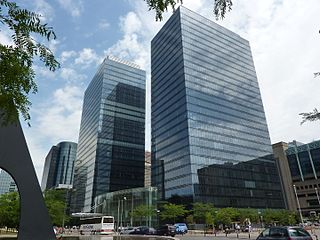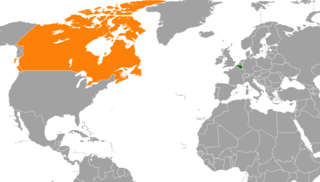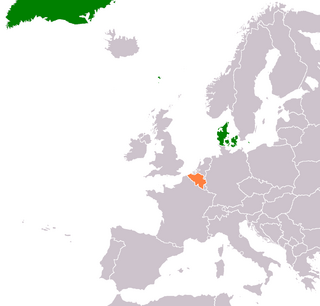
Belgium, officially the Kingdom of Belgium, is a country in Northwestern Europe. The country is bordered by the Netherlands to the north, Germany to the east, Luxembourg to the southeast, France to the south, and the North Sea to the west. It covers an area of 30,689 km2 (11,849 sq mi) and has a population of more than 11.5 million, making it the 22nd most densely populated country in the world and the 6th most densely populated country in Europe, with a density of 376/km2 (970/sq mi). Belgium is part of an area known as the Low Countries, historically a somewhat larger region than the Benelux group of states, as it also included parts of northern France. The capital and largest metropolitan region is Brussels; other major cities are Antwerp, Ghent, Charleroi, Liège, Bruges, Namur, and Leuven.

Flanders is the Dutch-speaking northern portion of Belgium and one of the communities, regions and language areas of Belgium. However, there are several overlapping definitions, including ones related to culture, language, politics, and history, and sometimes involving neighbouring countries. The demonym associated with Flanders is Fleming, while the corresponding adjective is Flemish, which can also refer to the collective of Dutch dialects spoken in that area, or more generally the Belgian variant of Standard Dutch. The official capital of Flanders is the City of Brussels, although the Brussels-Capital Region that includes it has an independent regional government. The powers of the government of Flanders consist, among others, of economic affairs in the Flemish Region and the community aspects of Flanders life in Brussels, such as Flemish culture and education.

The economy of Belgium is a highly developed, high-income, mixed economy.

Limburg, also known as Belgian Limburg, is a province in Belgium. It is the easternmost of the five Dutch-speaking provinces that together form the Region of Flanders, one of the three main political and cultural sub-divisions of modern-day Belgium.

Belgian culture involves both the aspects shared by all Belgians regardless of the language they speak and the differences between the main cultural communities: the Dutch-speaking Belgians (Flemish) and the French-speaking Belgians. Most Belgians view their culture as an integral part of European culture.

Vlaams Blok was the name of a Belgian far-right and secessionist political party with an anti-immigration platform. Its ideologies embraced Flemish nationalism, calling for the independence of Flanders. The party originated from split within the Volksunie (VU) party after the right-wing separatist and national conservative wing became disgruntled with the compromise of accepting Belgian federalism over Flemish interests, and what they saw as the VU's move to the left. The former VU members created the Flemish National Party (VNP) and the Flemish People's Party (VVP) which formed an electoral alliance called Vlaams Blok in 1978, before merging to create Vlaams Blok as a political party in 1979. Vlaams Blok was the most notable militant right wing of the Flemish movement and its track record in the Flemish and Belgian parliament elections was strong, making it one of the most successful nationalist parties in Western Europe and it ultimately surpassed the People's Union in support. The party initially focused solely on the issues of Flemish autonomy and political freedom, which remained its core philosophy, but subsequently gained wider public support through broadening its campaigns to include immigration and law-and-order themes.
De Vos is a Dutch-language surname meaning "the fox". In 2007 in the Netherlands, nearly all ≈11,000 people with the name spelled it de Vos, while in 2008 in Belgium, primarily in East Flanders, nearly all ≈11,000 people with the name capitalized it De Vos. Another 9220 people in Belgium, mostly in West Flanders have the concatenated form Devos, while in the United States the form DeVos can be found.
Belgian Americans are Americans who can trace their ancestry to people from Belgium who immigrated to the United States. While the first natives of the then-Southern Netherlands arrived in America in the 17th century, the majority of Belgian immigrants arrived during the 19th and 20th centuries.

The Kingdom of Belgium has three official languages: Dutch, French, and German.

Belgium–Canada relations are those between the nations of Belgium and Canada. Both are close allies and members of NATO and Francophonie. Both have a stance of multilateralism. The two nations have official bilingualism, and similar federal government systems owing in part to language tensions in both. Both were actively involved in the war in Afghanistan under ISAF.

Foreign relations between Belgium and Mexico commenced in 1836, when Belgium—itself newly independent—recognized the independence of Mexico. In 1919, the Belgian Chamber of Commerce of Mexico was established. Both nations are members of the Organisation for Economic Co-operation and Development and the United Nations.
Danny Matthys is a Flemish - Belgian visual artist, which was originally known as conceptual artist of international reputation. In the beginning of his career in the 1960s, he was a pioneer in Polaroid art and Video art.

Philips Augustijn Immenraet was a Flemish landscape painter and engraver. While staying largely within the traditional scheme of the Flemish Baroque landscape, Immenraet introduced a new brightness and broke with the traditional compositional scheme of obliquely receding planes. His best works already display a pre-Romantic character.

Belgium–Denmark relations refers to the current and historical relations between Belgium and Denmark. Belgium has an embassy in Copenhagen, while Denmark has an embassy in Brussels. Both countries are furthermore members of the European Union and NATO.

The Republic of Texas was a North American nation from 1836 to 1846; in its short time it established diplomatic relations worldwide, mainly through the cotton trade.
Despite its size, Belgium has a long and distinguished artistic tradition that goes back to the Middle Ages, considerably pre-dating the foundation of the current state in 1830. Art from the areas making up modern Belgium is called in English Netherlandish up to the separation with the Netherlands from 1570 on, and Flemish until the 18th century.

Mennonites in Argentina belong to two quite different groups: conservative and very conservative Plautdietsch-speaking group of Russian Mennonites who are descendants of Frisian, Flemish and Prussian people, and converts to the Mennonite faith from the general Argentinian population. The Russian Mennonites are the third largest community of Mennonites in South America, with six colonies in Argentina. While Russian Mennonites have their own language and customs and live in colonies, converts to the Mennonite faith normally live in cities and speak Spanish and do not differ much from other Protestants in Argentina. Conservative ethnic Mennonites normally do not engage in missionary activities but look for a quiet and remote place where they can live according to their tradition. More liberal Mennonites are engaged in worldwide missionary work like other North American Protestant denominations. About one third of Mennonites in Argentina are conservative ethnic Mennonites who belong to the Altkolonier branch.
Immigration in Guatemala constitutes less than 1%, approximately 140,000 people, and most come from neighboring countries. Guatemala's historic ethnic composition is mostly immigrant stock from Europe and as well as Asian and Africans brought during the era of slavery. Currently, the composition of Guatemala consists mostly of mestizos, Amerindians and Europeans, and to a lesser extent, Garifuna. In recent decades, immigration to Guatemala has led to an increase in desire for more businesses and tourist attractions, after there had been a considerable drop from 1950 to 1980.
Dutch Mexicans are Mexican citizens of Dutch descent.

Italian Belgians are Belgian citizens of Italian descent. The term may also refer to someone who has immigrated to Belgium from Italy.













